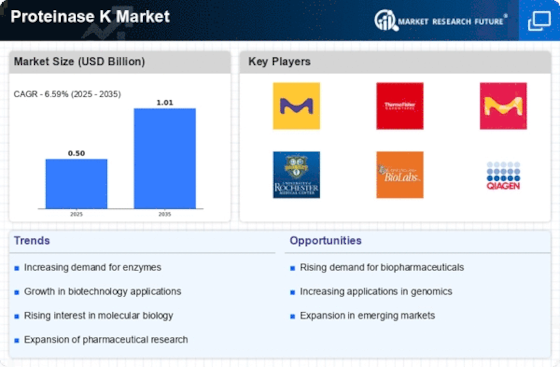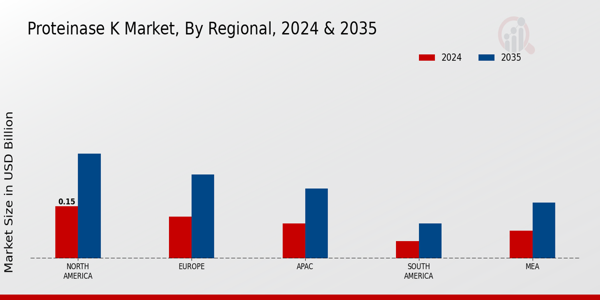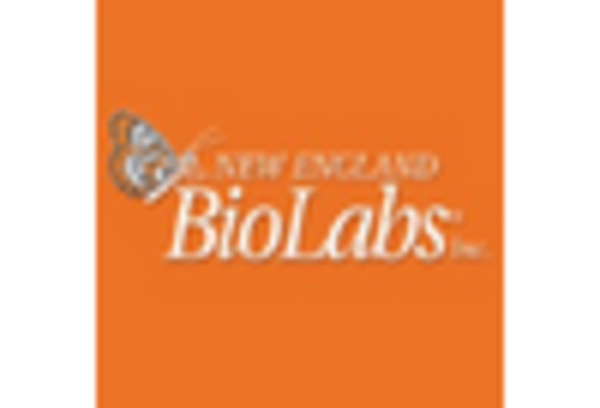Expansion of Biotechnology Sector
The Proteinase K Market is positively impacted by the expansion of the biotechnology sector. As biotechnological applications proliferate across various industries, including agriculture, healthcare, and environmental science, the demand for enzymes like Proteinase K is expected to rise. This enzyme is integral to numerous biotechnological processes, such as cloning, sequencing, and protein analysis. Market data suggests that the biotechnology sector has experienced a growth rate of approximately 18% annually, which correlates with an increased need for Proteinase K. This expansion indicates a favorable outlook for the Proteinase K Market, as the enzyme becomes increasingly essential in supporting the diverse applications within biotechnology.
Growing Focus on Genomic Research
The Proteinase K Market is witnessing growth driven by a growing focus on genomic research. As the importance of genomics in understanding diseases and developing personalized medicine becomes more pronounced, the demand for enzymes that facilitate genomic studies is increasing. Proteinase K plays a crucial role in the extraction and purification of nucleic acids, which are essential for genomic analysis. Recent Market Research Future indicate that the genomic research sector has expanded by 25% in the last year, with Proteinase K being a key component in many of these studies. This trend underscores the potential for the Proteinase K Market to thrive as genomic research continues to gain momentum and funding.
Rising Demand in Pharmaceutical Research
The Proteinase K Market is significantly influenced by the rising demand in pharmaceutical research. As the pharmaceutical sector continues to innovate, the need for high-quality enzymes for drug development and testing becomes paramount. Proteinase K is utilized in various stages of drug formulation, including the analysis of protein structures and the development of therapeutic proteins. Recent market data suggests that the pharmaceutical industry has seen a 20% increase in the utilization of Proteinase K for research purposes, driven by the need for more efficient and effective drug development processes. This growing reliance on Proteinase K indicates a promising trajectory for the Proteinase K Market, as pharmaceutical companies increasingly seek reliable enzymes to enhance their research capabilities.
Increasing Applications in Molecular Biology
The Proteinase K Market is experiencing a surge in demand due to its increasing applications in molecular biology. This enzyme is pivotal in various processes such as DNA and RNA extraction, protein digestion, and sample preparation. The versatility of Proteinase K makes it a preferred choice among researchers and laboratories. As the field of molecular biology expands, particularly in genetic research and diagnostics, the need for reliable enzymes like Proteinase K is likely to grow. Market data indicates that the enzyme's usage in research laboratories has increased by approximately 15% over the past year, reflecting a robust trend towards its adoption in diverse applications. This trend suggests that the Proteinase K Market is poised for continued growth as more laboratories recognize the benefits of utilizing this enzyme in their workflows.
Technological Advancements in Enzyme Production
The Proteinase K Market is benefiting from technological advancements in enzyme production. Innovations in biotechnology have led to more efficient methods for producing Proteinase K, resulting in higher purity and activity levels. These advancements not only improve the quality of the enzyme but also reduce production costs, making it more accessible to laboratories and research institutions. Market data reveals that the introduction of recombinant DNA technology has increased the yield of Proteinase K by approximately 30%, thereby enhancing its availability in the market. This trend suggests that as production technologies continue to evolve, the Proteinase K Market will likely experience a boost in both supply and demand, facilitating broader adoption across various sectors.


















Leave a Comment